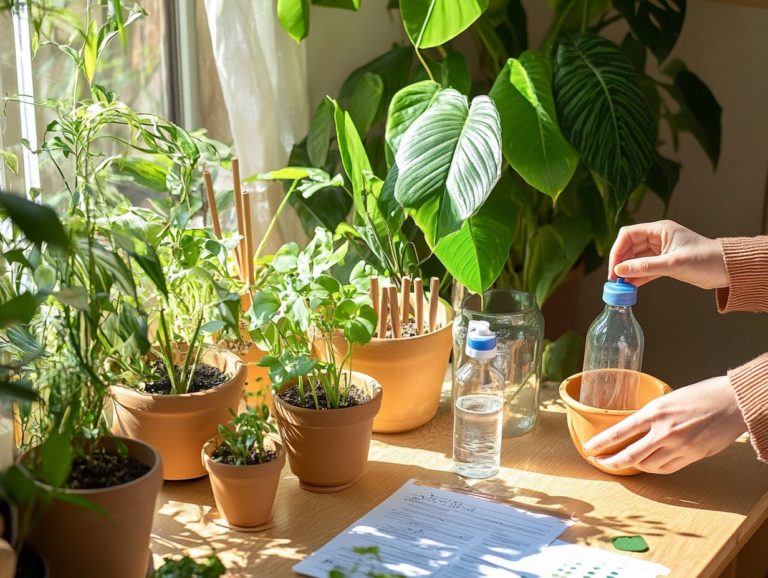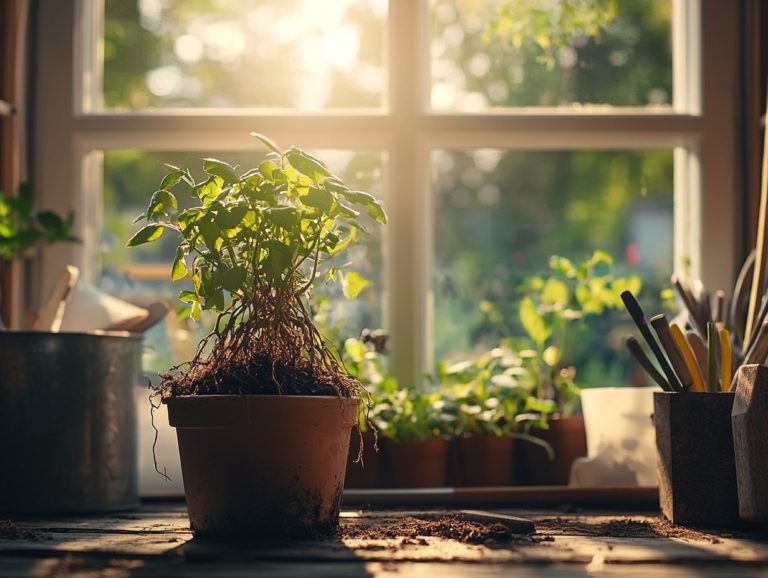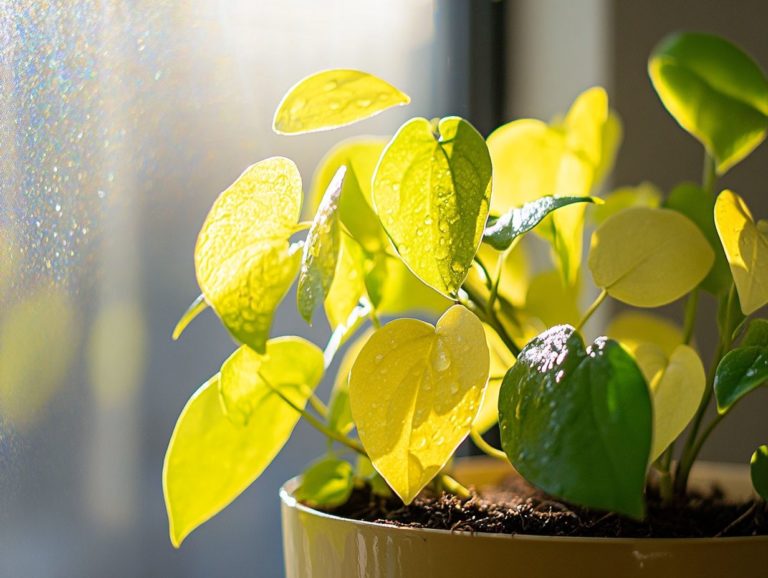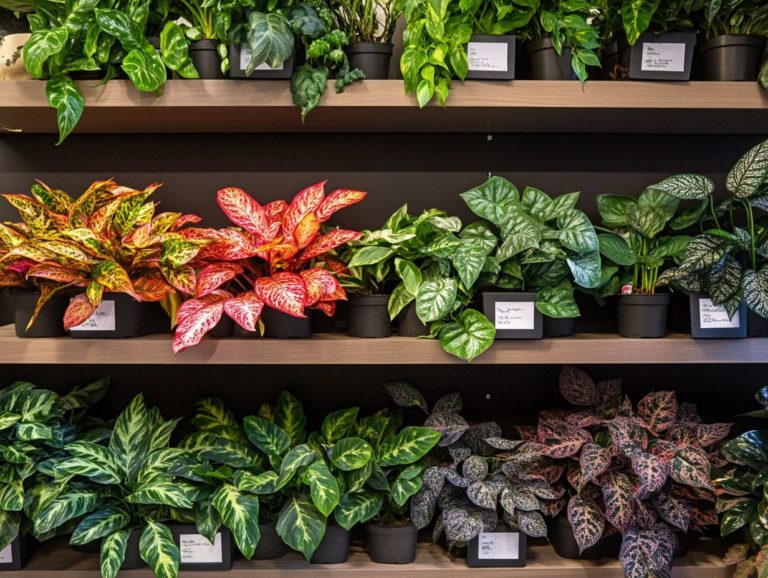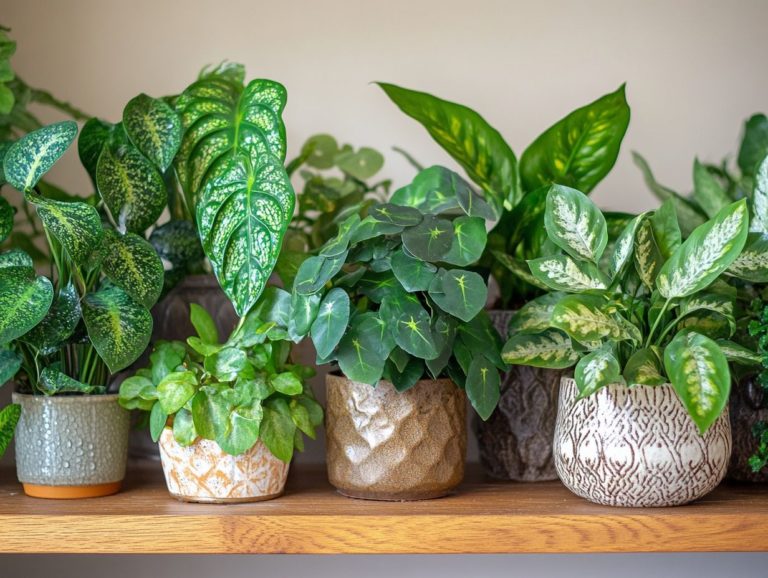Can Indoor Plants Survive in Dark Rooms?
Struggling to keep your indoor plants thriving in low-light conditions? You’re in great company! Many plant enthusiasts face the challenge of nurturing greenery in darker spaces, but understanding their light needs can truly make a significant impact.
This article explores the essentials of how plants use light to grow and the specific light requirements of your plants. It also highlights resilient species that thrive in low light and offers crucial care tips. It addresses common mistakes and explores alternative lighting options to ensure your indoor garden flourishes, no matter how dim your environment may be.
Prepare to transform your indoor oasis!
Contents
- Key Takeaways:
- Know Your Indoor Plants Light Needs for Healthy Growth
- Indoor Plants that Can Thrive in Low Light Conditions
- How to Care for Indoor Plants in Dark Rooms
- Common Mistakes in Growing Indoor Plants in Dark Rooms
- Alternatives to Natural Light for Indoor Plants
- Frequently Asked Questions
- Can Indoor Plants Survive in Dark Rooms?
- What are the signs that my indoor plant is not getting enough light?
- How can I help my indoor plants survive in a dark room?
- Will placing my indoor plant near a window be enough to provide adequate light?
- Can too much artificial light harm my indoor plants?
- Can indoor plants survive in completely dark rooms?
Key Takeaways:
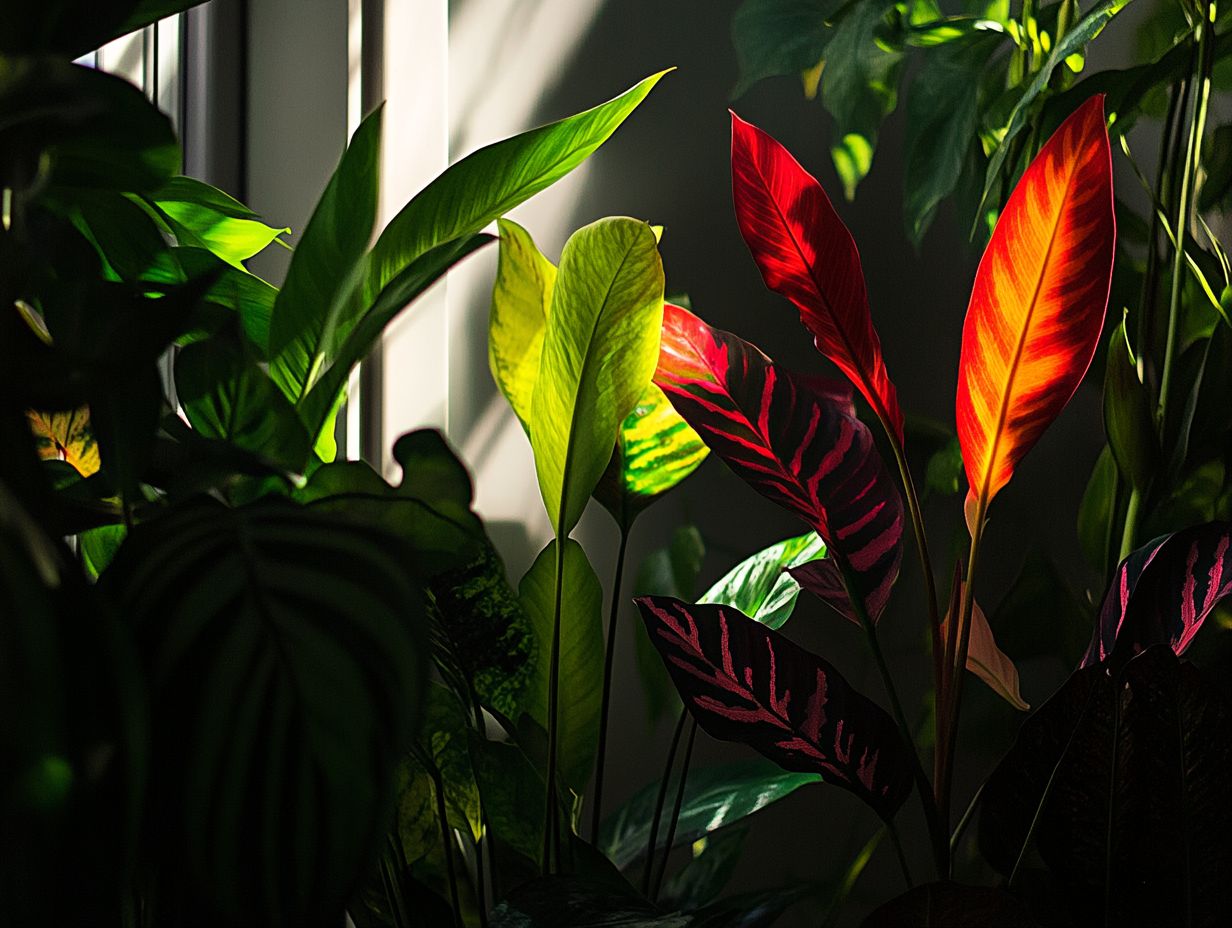
- Indoor plants can survive in dark rooms, but they need adequate light for growth.
- Some plants, such as pothos, peace lilies, spider plants, and ZZ plants, are well-adapted to low light and are great options for dark rooms.
- To care for indoor plants in dark rooms, provide artificial lighting and avoid common mistakes like overwatering.
Know Your Indoor Plants Light Needs for Healthy Growth
Understanding the light requirements of indoor plants is essential for cultivating thriving houseplants, especially where natural light is limited. Many plant lovers find it challenging to create ideal lighting conditions in dimly lit spaces, which can greatly affect the health and growth of their plants.
By learning about the light needs of various low-light species like the beloved peace lily, snake plant, ZZ plant, and other low-light plants, you can significantly enhance your plants’ vitality while boosting air purification in your home.
Photosynthesis and Light Requirements
Photosynthesis is the way plants use light to grow, making it crucial for you to understand the light needs of different species. This natural process not only provides energy for your plants but also plays a vital role in maintaining the health of your indoor gardening ecosystem.
Insufficient light can stunt growth, lead to yellowing leaves, and even risk plant death. For example, while succulents and cacti thrive in bright, direct light, ferns, like the Maidenhair fern, prefer lower, indirect light. Understanding indoor plant light needs is vital for anyone wanting to cultivate a vibrant indoor garden.
Indoor Plants that Can Thrive in Low Light Conditions
As an indoor gardening enthusiast, you’re likely looking for low-light plants that can thrive in dim conditions. It’s essential to identify which varieties excel in these environments.
Among the most beloved options, the peace lily stands out with its stunning white blooms, while the resilient snake plant can survive with minimal light.
Other noteworthy options include:
- ZZ plant: Known for its tolerance to neglect.
- Philodendron: Adapts well to low light and is easy to care for.
- Pothos: Fast-growing and very forgiving.
- Spider plant: Great for air purification.
- Dracaena: Offers a variety of species that thrive in low light.
All of these plants promise robust growth and require minimal care in darker spaces, ensuring an enjoyable gardening experience. These low-light plants are perfect for indoor gardening enthusiasts.
Act now to keep your plants thriving and explore more about indoor gardening for expert tips!
In summary, understanding your indoor plants’ light needs and choosing the right species are essential for a flourishing indoor garden. By following these tips, you’ll create a vibrant space that enhances both your home and well-being.
Types of Plants and Their Adaptations
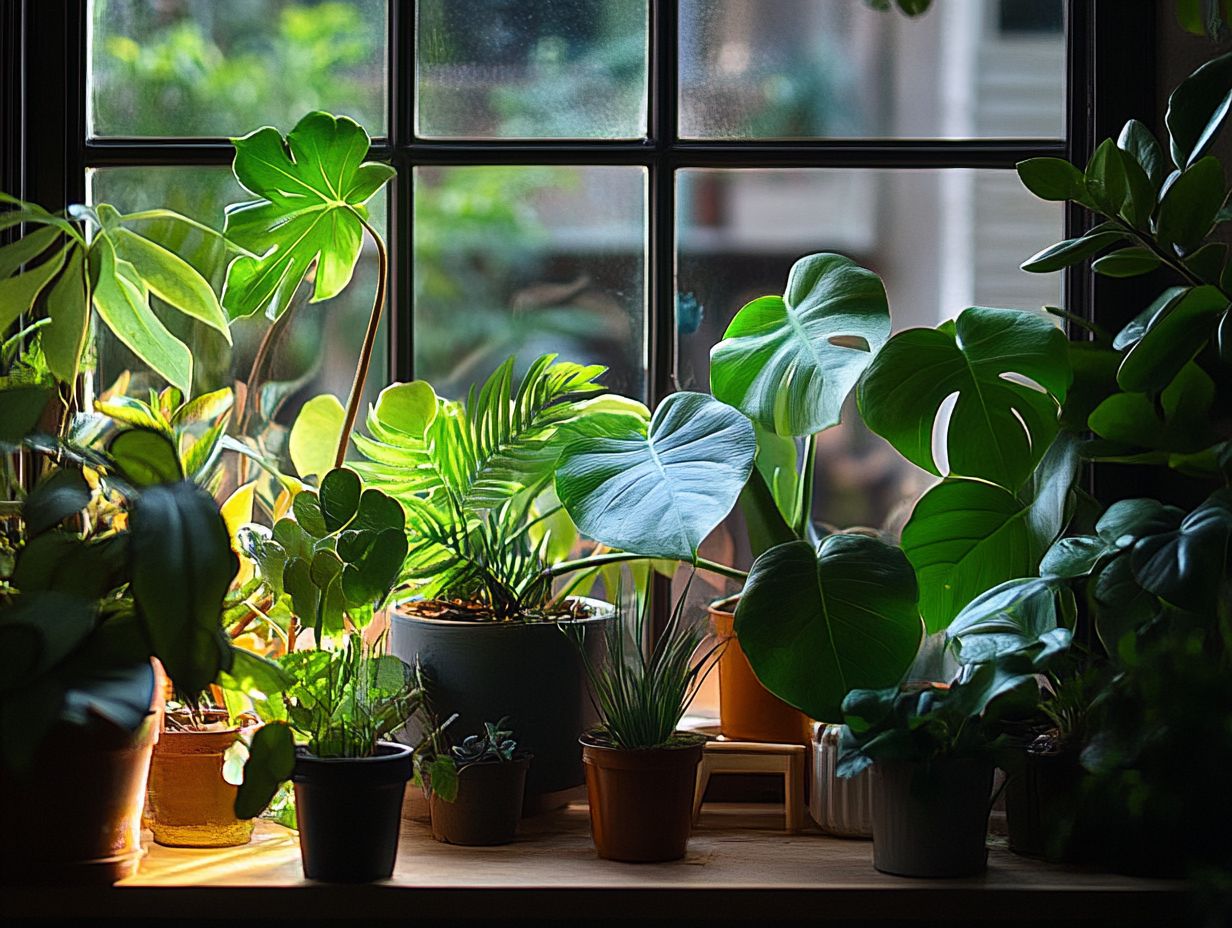
Different types of indoor plants showcase remarkable adaptations that allow them to thrive in low-light environments. Shade-loving varieties are perfect for indoor gardening enthusiasts who desire vibrant greenery in less-than-ideal conditions.
These adaptations reveal themselves in various ways. For example, specialized leaf structures maximize light capture while minimizing water loss. The spider plant flourishes in shaded corners and boasts impressive air-purifying qualities. With its long, arching leaves, it captures scattered light with ease, making it one of the best indoor foliage plants for low light.
Shade-loving varieties like pothos and peace lilies have evolved broad leaves to absorb as much light as possible in dim settings. Their growth patterns often emphasize verticality, reaching upward for any available light. For those looking to explore more options, check out low light indoor plants: top choices. This not only enhances their beauty but also showcases their resilience in indoor spaces.
How to Care for Indoor Plants in Dark Rooms
Caring for indoor plants in dimly lit spaces demands a customized strategy that considers lower light levels. These levels significantly impact watering, soil selection, and overall plant vitality.
One effective tip is to use a tool to check soil wetness. This helps you avoid the all-too-frequent blunder of overwatering in low-light environments.
Rotate your plants regularly to encourage even growth. Choosing the right soil types will enhance indoor conditions, allowing your plants to flourish even without abundant sunlight.
Tips for Providing Adequate Light and Water
To ensure your plants thrive in low-light environments, provide adequate light and tailored watering techniques that address the specific needs of each species, including considerations for humidity.
Many indoor gardeners find it crucial to master methods to enhance light levels when natural sunlight is scarce. Using artificial grow lights, like LEDs or fluorescent bulbs, replicates the spectrum that plants need to flourish, supplying energy for photosynthesis, the process plants use to make their food using light. To choose the best options for your space, check out the top indoor plants for varied lighting.
Understanding the distinct watering preferences of your plants is equally important. Some thrive in a humid environment, while others prefer drier soil. If you’re curious about which plants can flourish in less-than-ideal lighting, check out what indoor plants thrive in low light. By integrating these lighting solutions with personalized watering schedules, you can create a harmonious environment that fosters growth and vitality, even in challenging indoor conditions.
Common Mistakes in Growing Indoor Plants in Dark Rooms
As an indoor gardening enthusiast, you may face challenges when growing plants in dimly lit spaces. These hurdles often arise from misconceptions about light requirements and care practices that can put your plants’ health at risk.
Avoiding Overwatering and Other Pitfalls

Overwatering is one of the most common pitfalls in indoor gardening, especially for low-light plants. To avoid this mistake, grasp effective watering techniques and monitor soil moisture levels using a tool to check soil wetness.
Watch for signs of overwatering, such as yellowing leaves, fungal growth, and a soggy texture in the soil. Investing in a moisture meter can be a game changer. These handy tools provide precise readings of your soil’s moisture content, guiding you on the perfect timing for watering. Additionally, if you’re looking for how to choose indoor plants for low light, consider their specific watering needs.
Letting the soil dry out between waterings boosts root growth and prevents nasty root rot. Incorporate these practical strategies into your gardening routine to reduce the risk of overwatering and cultivate a thriving indoor garden.
Alternatives to Natural Light for Indoor Plants
In instances where natural light falls short for your indoor plants, considering alternatives like artificial grow lights can truly transform your indoor gardening experience.
For those passionate about nurturing their green companions, these lighting solutions can be the key to maintaining their health and vibrancy in dark rooms.
Artificial Lighting Options and Considerations
Artificial lighting options are essential for meeting the light needs of your indoor plants. These lights provide a spectrum that closely resembles natural sunlight, promoting optimal growth.
Different types of artificial lights LED, fluorescent, and incandescent suit various plant requirements and preferences. For those considering natural options, understanding the best indoor plants for low light can be beneficial. LEDs are particularly favored for their energy efficiency, long lifespan, and ability to emit specific colors of light that benefit plant growth.
Fluorescent lights offer broader coverage and are budget-friendly, making them an excellent choice for beginners. In contrast, incandescent bulbs are not ideal for most plants due to their high heat output and low energy efficiency. However, they can still be useful in small, short-term situations. For those looking to enhance their space, consider indoor plants that thrive in low light for a beautiful touch.
Understanding the benefits and drawbacks of each type helps you choose the best lighting options for your plants, ensuring they flourish indoors. Don t wait! Make the right lighting choice now to keep your plants thriving!
Frequently Asked Questions
Can Indoor Plants Survive in Dark Rooms?

While most indoor plants require some light to survive, certain varieties can thrive in low light conditions. These include Chinese evergreens, pothos, and snake plants.
What are the signs that my indoor plant is not getting enough light?
Understanding the light requirements of your plants can help you identify issues early. If your indoor plant is not getting enough light, it may start to wilt, lose its vibrant color, or show yellowing leaves. You might also notice stunted growth or the plant leaning towards a light source.
How can I help my indoor plants survive in a dark room?
If your plant is not getting enough light, consider moving it to a brighter location. You can also provide artificial light with a grow light or opt for a low light tolerant plant for your dark room.
Will placing my indoor plant near a window be enough to provide adequate light?
It depends on the window and the plant. South-facing windows usually provide the most light, while north-facing windows may not offer enough. Some plants need more light than others.
Can too much artificial light harm my indoor plants?
Yes, excessive artificial light can harm your indoor plants. Follow the instructions for your grow light and give your plants a break by turning the light off for a few hours each day.
Can indoor plants survive in completely dark rooms?
No, all plants need some amount of light to survive. If your room lacks natural or artificial light, your best option is to choose a low light tolerant plant and occasionally rotate it to a location with some light.
Explore more options for plant care and consider purchasing grow lights to ensure your indoor garden thrives!


